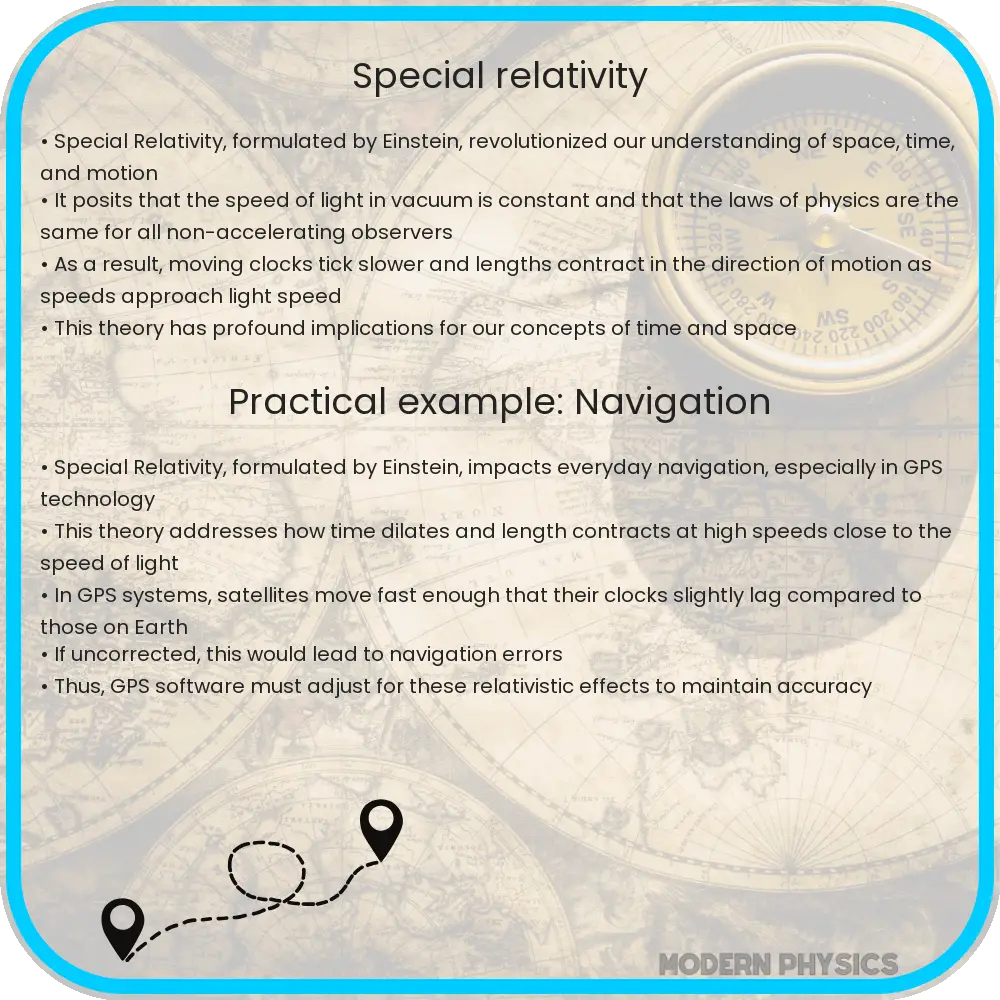An in-depth exploration of Special Relativity, covering time dilation, length contraction, and the mass-energy equivalence formula, E=mc2, proposed by Albert Einstein.

Introduction to Special Relativity
Special relativity is a fundamental theory in physics developed by Albert Einstein in 1905. It revolutionized our understanding of time, space, and energy. The theory primarily deals with the physics of objects moving at constant speeds close to the speed of light. Here, we’ll explore three pivotal concepts of special relativity: time dilation, length contraction, and the mass-energy equivalence formula, E=mc2.
Time Dilation
Time dilation is a phenomenon where time, as measured by a clock moving at a high velocity, is observed to pass slower compared to a clock at rest. This effect becomes very significant at speeds close to the speed of light. The mathematical expression for time dilation is:
\[ t’ = \frac{t}{\sqrt{1 – v^2/c^2}} \]
where:
- t’ is the time interval observed in the moving frame,
- t is the time interval observed in the stationary frame,
- v is the velocity of the moving frame relative to the stationary frame, and
- c is the speed of light in vacuum.
This means that if one were to travel at a speed close to the speed of light, time would seemingly “slow down” for them relative to someone who remained stationary.
Length Contraction
Length contraction describes how the length of an object moving at a relativistic speed will appear shorter to a stationary observer. In other words, objects in motion are measured to be shorter in the direction of motion than they are at rest. The formula for length contraction is:
\[ L’ = L \sqrt{1 – v^2/c^2} \]
where:
- L’ is the contracted length as observed in the stationary frame,
- L is the proper length (the length of the object in its rest frame),
- v is the velocity at which the object is moving relative to the observer,
- c is the speed of light in vacuum.
This effect becomes noticeable only when objects move at speeds close to that of light, making it a truly relativistic phenomenon.
Mass-Energy Equivalence
The equation \( E=mc^2 \) is perhaps the most famous result of Einstein’s theory of special relativity. This mass-energy equivalence formula tells us that mass can be converted into energy and vice versa. It signifies that even a small amount of mass can produce a huge amount of energy.
The formula is given by:
\[ E = mc^2 \]
where:
- E is the energy,
- m is the mass,
- c is the speed of light in vacuum.
This principle is fundamental in both physics and engineering, explaining processes ranging from nuclear reactions to the energy released in particle accelerators.
Relativity in Modern Applications
Applications of special relativity are numerous and impact various fields. For instance, the Global Positioning System (GPS) that helps in navigation would not be accurate without corrections for relativistic effects. Another example is particle accelerators, which use relativistic principles to accelerate particles to high speeds before collisions.
Even understanding cosmic phenomena, such as black holes and the behavior of light near them, relies on principles of special relativity. These examples underscore the theory’s broad applicability beyond theoretical physics into practical engineering and technology sectors.
Conclusion
Understanding special relativity is essential not only for physicists but also for engineers and technologists. The theory provides a framework for interpreting various phenomena in the universe and has led to significant technological advancements. From GPS navigation to the exploration of cosmic phenomena, the implications of Einstein’s insights into the nature of time, space, and energy continue to influence science and technology profoundly.
By grasping concepts like time dilation, length contraction, and mass-energy equivalence, we can appreciate the elegance of the universe’s laws and develop technologies that were once thought impossible. Special relativity not only alters our understanding of motion and energy but also challenges our perceptions, inviting us to think in new and innovative ways.
